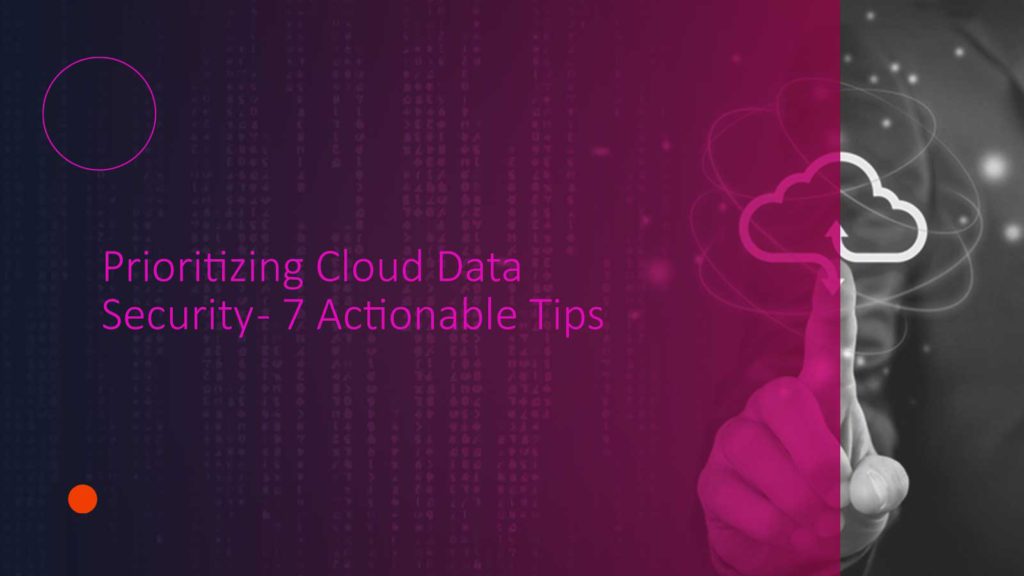Do you know that 45% of security breaches in an organization are cloud-based? Cloud computing is a convenient way to store data, plus it saves money — but of course, not without some risks. Cloud data security is all about understanding these loopholes in your cloud network and tackling them with the help of technology.
Cloud Data security-related incidents have risen sharply in the last few years, and even so, businesses prefer the cloud for benefits in areas of cost and scalability. As data migration to the cloud becomes a norm, understanding and addressing cloud security challenges should be paramount.
Cloud data security is all about protecting an organization’s data from loss, unauthorized access, and misuse in cloud-based environments. This protection applies to data both at rest and in transit (to and from the cloud), whether managed internally or by any third-party cloud service provider.
A strong cloud data security strategy should include:
- Securing data storage across networks, applications, and cloud platforms
- Vigilant monitoring of changes in the cloud environment at all times
- Strict access control to data, devices, and software
- Proactive identification and mitigation of emerging cloud risks, establishment of full-fledged data security policies
Let us find out how you, as an organization, can ensure the security of your cloud data.
Is Your Cloud Data Secure?
Although, in itself, cloud storage is not less secure than the traditional ways of storing data, the reality is that in 2023, 82% of data breaches exposed cloud-stored information. This indicates the unique vulnerabilities of cloud environments.
Many organizations blindly trust their current security measures or fall into the trap of thinking that all security aspects are taken care of by the cloud provider. Neither of these beliefs is accurate. The cloud presents a new attack surface and requires unique strategies for security.
The responsibility of cloud security rests with both the cloud provider and the customer. Except in cases where the latter has secured the underlying infrastructure, customers are responsible for securing data, applications, and configurations within the cloud environment.
To ensure appropriate protection, an organization,
- Should develop a cloud-specific security strategy.
- Should understand its shared responsibility with the cloud provider, which is usually explained within a Customer Responsibility Matrix.
- Should put in place effective security controls at the infrastructure and application levels.
By identifying these key points and working on them, a business can massively improve its cloud data security posture.
The Critical Need for Cloud Data Security
Organizations are gathering record-setting volumes of data today—most of it resides in the cloud and spreads across multiple platforms. This has introduced new security problems with this rapid digital transformation:
- Data visibility: Its location, understanding how it is distributed
- Access control: Knowing who, when, and why certain data is accessed.
- Cloud provider security: Assess the security controls within the cloud providers.
- Threat mitigation: Prevention of breaches, loss of data, and malware.
- Compliance: Compliance with intricate data protection regulations like GDPR and CCPA.
The cost of poor cloud data security is very significant. In particular, some of the more pronounced expected outcomes for a security breach include massive fines, irredeemable reputation damage, fiscal loss, and organizational disruption. Large incidents, such as the Capital One data breach, have been stark reminders of what could be sustained.
Countermeasures suited to mitigate these risks involve a comprehensive strategy for cloud data security in protecting sensitive information. That is to say, implementing effective measures against these threats to the data so that organizations may remain safe and in compliance with regulatory provisions.

Tips For Prioritizing Cloud Data Security
1. Shared Responsibility
One of the core principles of cloud security is shared responsibility. This includes the distribution of responsibilities between the customer and the cloud provider. The cloud provider has responsibility for the security of the cloud, while customers are responsible for following security measures while using the cloud. One of the most important things the customer can do is to be very clear about your responsibilities, and then work with your cloud provider in the design of a solid security framework.
2. Establish Effective Access Controls
Needless to say, access control to your cloud data is very important. Here, the least privilege should be the approach, where every user should be given only such privileges actually required by them to execute their job role. Provide multi-factor authentication (MFA). Review and update access controls regularly to ensure they remain relevant and effective against risks.
3. Encrypt Your Data
Encryption forms the basis of Cloud Security. Encrypt data both when stored and while in transit to prevent unauthorized access. Considering the best industry algorithms for encryption, the keys should be up to date. You may consider a key management service that can simplify this process.
4. Regular Patching and Updates
Keep your cloud infrastructure, applications, and operating systems up to date with latest patches and updates. A great majority of these updates actually have patches that cover vulnerabilities that cybercriminals can potentially use to their advantage. Automate the process of patching as much as you can to ensure timely application of security fixes.
5. Monitoring and Logging of Activities
It is important to carry out constant monitoring of cloud environments to identify anomalous activities and potential threats. Impose a strict logging and auditing mechanism in the tracking of user activities, system events, and security incidents. Logs must be analyzed constantly for trends in their use and alerts on potential security breaches.
6. Regular Security Assessment
Regular security assessments; for example, penetration testing, vulnerability scanning, and risk assessment; will reveal the gap areas whose leaks must be mended. Stay updated on new threats and best security practices implemented for any modification of security measures.
7. Backup Your Data
Data loss can be disastrous. Create a backup plan that includes the regular execution of backups for your data in the cloud to a secure location off-site. Regularly test and restore data, ensuring your backup plan is effective.
Read our latest News: Stephen Moss Joins Cowbell’s Board of Directors
Following these points and ensuring constant vigilance regarding cloud security can considerably lower the rate at which data breaches take place and, in turn, help secure the most valuable assets of your company.
Conclusion:
In a nutshell, cloud data security is not about implementing technology alone. It is an inclusive activity comprising shared responsibility, tight access control, encryption, timely patching, constant monitoring, and proactive assessment. This following of actionable steps and inculcation of a security culture in your organization will largely prevent the possible risks of computing on the cloud. The real way to genuine cloud data security remains vigilance, education, and a strong incident response strategy. Protect your data today, and you will have secured your organization’s future in a world that is becoming increasingly dependent on the cloud with each passing day.
To share your insights with CyberTech Newsroom, please write to us at news@intentamplify.com








